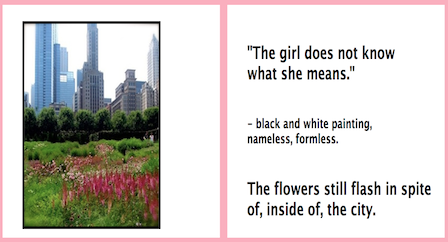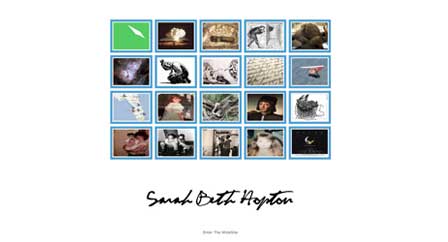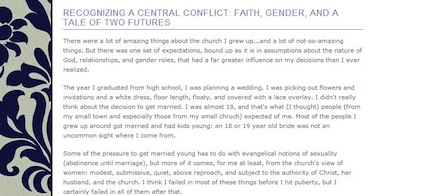Our [Electrate] Stories
Explicating Ulmer's Mystory Genre
Marc C. Santos, Ella R. Bieze, Lauren E. Cagle, Jason C., Zachary P. Dixon, Kristen N. Gay, Sarah Beth Hopton, Megan M. McIntyre
References
Arroyo, Sarah J. (2005). Playing to the tune of electracy: From post-process to a pedagogy otherwise. JAC, 25(4), 683-715.
Barthes, Roland. (1981). Camera lucida: Reflections on photography. (Richard Howard, Trans.). New York, NY: Hill and Wang.
Bataille, Georges. (1929). Critical Dictionary. Encyclopaedia Acephalica, 29-84.
Berlin, James. (1988). Rhetoric and ideology in the writing classroom. College English, 50(5), 477-494.
Bizzell, Patricia. (1994). Contact zones and English studies. College English, 56(2), 163-169.
Bizzell, Patricia. (1996). Fredric Jameson and composition studies. JAC, 16(3), 471-487.
Brooke, Collin G. (2009). Lingua fracta: Toward a rhetoric of new media. Cresskill, NJ: Hampton Press.
Burke, Kenneth. (1984). Permanence and change: An anatomy of purpose. Berkeley, CA: University of California Press.
Butler, Judith. (2006). Gender trouble: Feminism and the subversion of identity. (10th anniversary ed.) London: Routledge.
Cicero. (1986). On oratory and orators. (J.S. Watson, Trans.). Carbondale, IL: Southern Illinois University Press.
Corder, Jim W. (1985). Argument as emergence, rhetoric as love. Rhetoric Review, 4(1), 16-32.
Davis, Diane. (2010). Inessential solidarity: Rhetoric and foreigner relations. Pittsburgh, PA: University of Pittsburgh Press.
Deleuze, Gilles, & Guattari, Felix. (1987). A thousand plateaus: Capitalism and schizophrenia. (Brian Massumi, Trans.). Minneapolis, MN: University of Minnesota Press.
Derrida, Jacques. (1988). Limited, inc. (Gerald Graff, Ed.). (Jeffrey Mehlman and Samuel Weber, Trans.). Chicago, IL: Northwestern University Press.
Derrida, Jacques. (1997). Of grammatology. (Gayatri Chakravorty Spivak, Trans.). Baltimore, MD: John Hopkins University Press.
Derrida, Jacques. (2005). Paper machines. (Rachel Bowlby, Trans.). Stanford, CA: Stanford University Press.
Faigley, Lester. (1992). Fragments of rationality: Postmodernity and the subject of composition. Pittsburgh, PA: University of Pittsburgh Press.
Freire, Paulo. (2000). Pedagogy of the oppressed. New York, NY: Continuum Press.
Gaonkar, Dilip Parameshwar. (1993). The idea of rhetoric in the rhetoric of science. Southern Journal of Communication, 58(4), 258-295.
Geisler, Cheryl. (2004). How ought we to understand the concept of rhetorical agency? Report from the ARS. Rhetoric Society Quarterly, 34(3), 9-17.
Glenn, Cheryl. (2004). Unspoken: A rhetoric of silence. Carbondale, IL: Southern Illinois University Press.
Glenn, Cheryl, & Ratcliffe, Krista (Eds.). (2011). Silence and listening as rhetorical arts. Carbondale, IL: Southern Illinois University Press.
Goncalves, Zan Meyer. (2005). Sexuality and the politics of ethos in the writing classroom. Carbondale, IL: Southern Illinois University Press.
Haraway, Donna J. (1991). A cyborg manifesto: Science, technology, and socialist-feminism in the late twentieth century. Simians, cyborgs, and women: The reinvention of nature (pp. 149–182). New York, NY: Routledge.
Haraway, Donna J. (1988). Situated knowledges: The science question in feminism and the privilege of partial perspective. Feminist Studies, 17(3), 575-599.
Hart-Davidson, Bill, Krause, Steven D., Carbone, Nick, Day, Michael, English, Joel, Harris, Trish, Johnson-Eilola, Johndan, Krause, Steven D., Nellen, Ted, Palmquist, Mike, Rice, Rich, & Rickly, Rebecca. (2004). Re: The future of computers and writing: A multivocal textumentary. Computers and Composition, 21, 147-160.
Hawk, Byron. (2007). A counter-history of composition: Toward methodologies of complexity. Pittsburgh, PA: University of Pittsburgh Press.
Hayles, N. Katherine. (1999). How we became posthuman. Chicago, IL: University of Chicago Press.
Holmevik, Jan Rune. (2012). Inter/vention: Free play in the age of electracy. Cambridge, MA: MIT Press.
Kelly, Kevin. (2013). The Technium. KK*. Retrieved from http://www.kk.org/thetechnium/
Kopelson, Karen. (2003). Rhetoric on the edge of cunning; Or, the performance of neutrality (re)considered as a composition pedagogy for student resistance. College Composition and Communication, 55(1), 115-146.
Kristeva, Julia. (1991). Strangers to ourselves. (Leon S. Roudiez, Trans.). New York, NY: Columbia University Press.
Lakoff, George. (2004). Don’t think of an elephant: Know your values and frame the debate. White River Junction, VT: Chelsea Green Press.
Latour, Bruno. (1993). We have never been modern. Cambridge, MA: Harvard University Press.
Latour, Bruno. (1996). Pandora's hope: Essays on the reality of science studies. Cambridge, MA: Harvard University Press.
Latour, Bruno. (2004). Politics of nature: How to bring the sciences into democracy. Cambridge, MA: Harvard University Press.
Lugones, Maria. (1997). Playfulness, “world”-travelling, and loving perception. In Diana Tietjens Meyers (Ed.), Feminist social thought: A reader (pp. 147-59). New York, NY: Routledge.
Miller, Adam S. (2013). Speculative grace: Bruno Latour and object-oriented theology. New York, NY: Fordham University Press.
Murray, Donald. (1972). Teach writing as a process, not product. The Leaflet. pp. 11-14.
McLuhan, Marshall. (2011). The Gutenberg galaxy: The making of typograhic man. Toronto, Ontario: University of Toronto Press.
Nancy, Jean-Luc. (2007). Listening. Trans. Charlotte Mandell. Bronx, NY: Fordham University Press.
Oliver, Kelly. (2001). Witnessing: Beyond recognition. Minneapolis, MN: University of Minnesota Press.
Pratt, Mary Louise. (1991). Arts of the contact zone. Profession, 33-40. Retrieved from http://www.jstor.org/stable/25595469
Price Herndl, Diane. (2002). Reconstructing the posthuman feminist body twenty years after Audre Lorde's cancer journals. In Robyn Warhol-Down and Diane Price Herndl (Eds.), Feminisms redux: An anthology of literary theory and criticism (pp. 477-86). New Brunswick, New Jersey: Rutgers University Press.
Ong, Walter J. (1986). Writing is a technology that restructures thought. In Gerd Baumann (Ed.), The written word (pp. 23-50). Oxford, UK: Clarendon Press.
O'Reilly, Tim. (2005). What is web 2.0? Retrieved from http://oreilly.com/web2/archive/what-is-web-20.html
Ratcliffe, Krista. (2006). Rhetorical listening: Identification, gender, whiteness. Carbondale, IL: Southern Illinois University Press.
Rice, Jeff. (2007). The rhetoric of cool: Composition studies and new media. Carbondale, IL: Southern Illinois University Press.
Rickert, Thomas. (2007). Acts of enjoyment. Pittsburgh, PA: University of Pittsburgh Press.
Robinson, Ken. (2011). Out of our minds: Learning to be creative (2nd ed.). Chichester, West Sussex: Capstone Publishing.
Rosen, Philip (Ed.) (1986). Narrative, apparatus, ideology. New York, NY: Columbia University Press.
Santos, Marc C. (2011). How the Internet saved my daughter and how social media saved my family. Kairos: A Journal of Rhetoric, Technology, and Pedagogy, 15(2). Retrieved from http://www.technorhetoric.net/15.2/topoi/santos/index.html
Santos, Marc C., & Leahy, Mark H. (in press). Web writing and postpedagogy. Computers and Composition.
Schilb, John. (1996). Between the lines: Relating composition theory and literary theory. Portsmouth, NH: Boynton/Cook.
Shirky, Clay. (2008). Here comes everybody: The power of organizing without organizations. New York, NY: Penguin Press.
Sirc, Geoffrey. (2010). Serial composition. In Stuart A. Selber (Ed.), Rhetoric and technologies: New directions in writing and communication (pp. 56-73). Columbia, SC: University of South Carolina Press.
Suber, Peter. (2012). Open access. Cambridge, MA: The MIT Press.
Ulmer, Gregory L. (1985). Applied grammatology. Baltimore, MD: John Hopkins University Press.
Ulmer, Gregory L. (1989). Teletheory: Grammatology in the age of video. New York, NY: Routledge.
Ulmer, Gregory L. (2003). Internet invention: From literacy to electracy. New York, NY: Longman.
Ulmer, Gregory L. (2005). Electronic monuments. Minneapolis, MN: University of Minnesota Press.
Ulmer, Gregory L. (2012). Avatar emergency. Anderson, SC: Parlor Press.
Weinberger, David. (2007). Everything is miscellaneous. New York, NY: Times Books.
Zavarzadeh, Mas’ud. (1992). Pun(k) deconstruction and the postmodern political imaginary. Cultural Critique, 17, 5-45.
Notes
[1]
For further explication of the mystory genre, see Sarah J. Arroyo (2005, pp. 696-698) and Jan Rune Holmevik (2012).
[2]
For a detailed discussion of apparatus theory, focusing on its origins in cinema and relationships to psychoanalysis and poststructuralism, see Philip Rosen's (1986) Narrative, Apparatus, Ideology. Those in rhetoric and composition will likely be more familiar with the work of Walter Ong (1986) and/or Marshall McLuhan (2011), whose work on the relationship among communicative technologies, epistemology, and ideology influences both apparatus theory and Gregory L. Ulmer’s (2012) articulation of electracy.
Important to Ulmer’s (2012) project was that electracy does not merely replace literacy, just as literacy did not replace orality (p. 36). Rather, electracy competes against these other epochs. We find ourselves at a pivotal moment in this struggle, as electracy increasingly predominates our daily movements, yet by and large remains ostracized from our entrenched curricula.
[3]
N. Katherine Hayles (1999) explicated the sociological term skeuomorph as incorporating antiquated features into the design of new technologies in order to ease social transitions (pp. 13-18). One example of this would be Microsoft Word, which organizes digital documents using print concepts: files, folders, etc.
[4]
As will become apparent throughout this section, Gregory L. Ulmer’s reconceptualizing of subjectivity resonated with many postmodern and nonmodern critiques of the Modern subject, including Donna J. Haraway’s (1991) notion of the cyborg, Judith Butler’s (2006) performative problematizing of gender, Diane Davis’s (2010) notion of the subject as function of responsibility, or Bruno Latour’s (1996; 2004) networked actant. In other words, this postpedagogy resonates with several contemporary theoretical perspectives.
[5]
Lester Faigley (1992) explicated the postmodern challenge to modern subjectivity, arguing that subjectivity becomes “an effect rather than a cause of discourse” and agency becomes largely an illusion; the early 1990s also produced other critiques of unified subjectivity and rational agency. Following the critiques of Faigley, Dilip Parameshwar Gaonkar (1993), and others, Patricia Bizzell (1996) suggested we must begin to theorize a kind of rhetorical agency that works with the fractured nature of postmodern subjectivity. Of particular relevance to Ulmer’s project, though, may be the work of Cheryl Geisler (2004) and others, who have called attention to the ways in which digital technologies alter the possibilities for affecting change in postmodern contexts and offer new models of agency that don’t rely exclusively on unified human subjects. Ulmer’s work responds to Bizzell’s call.
[6]
For a concise and cogent explication of Bruno Latour and agency, see Adam S. Miller (2013).
[7]
Gregory L. Ulmer’s (2012) apparatus theory maintained that every epoch develops its own way of conceptualizing what constitutes, motivates, and bounds a human being. We follow Ulmer in referring to this general conceptual necessity as self; in orality, self is conceptualized as spirit in literacy as subject. Ulmer (2012) offered the concept of avatar for the conception of self in electracy.
[8]
Like Donna J. Haraway’s (1991) notion of the cyborg, Ulmer’s avatar moves us away from the singular, stable, Cartesian subject toward a multiple, materially-registered sense of self.
[9]
As discussed previously, Gregory L. Ulmer's (2003) Internet Invention used Roland Barthes' (1981) distinction between the studium and the punctum, between objective, cultural memory and subjective, affective memory. The dictionary, perhaps the representative production of literacy’s desire to objectify, homogenize, and order reality, offers studium. Barthes’ project of antidefinition, embraced by Ulmer, seeks to offer a(n electrate) foil to such objectivity with punctum. Lauren E. Cagle, Megan M. McIntyre, Jason C., and Sarah Beth Hopton drew on Barthes’ concepts of the studium and the punctum in their reflections; see especially the responses to question 1, "what work does the mystory do?".
[10]
For further explication of postpedagogy, see Sara J. Arroyo (2005), Thomas Rickert (2007), Marc C. Santos and Mark H. Leahy (in press).
[11]
Gregory L. Ulmer’s work resonates with Sir Ken Robinson’s (2011) critique of the lack of creativity in contemporary education. See Robinson (2011), especially pp. 49-79.
[12]
Given the intensely personal nature of the mystory, Ella Bieze chose not to include her mystory in the publication of this article. Similarly, Kristen Gay and Megan Mcintyre elected to supply only parts of their mystories for publication. We apologize for any 404 File Not Found errors users might experience.
We discuss the personal and public dimensions of the mystory in the question 5 reflection on whether a mystory should be public or private.
[13]
See Jan Rune Homlevik (2012, pp. 6-14) for further explication.
[14]
Perhaps there is no stronger example of this, of a clash between literate and electrate institutions of power, than the January 2012 Internet blackout in protest of the Stop Online Piracy Act (SOPA) and Protect Intellectual Property Act (PIPA).
[15]
My particular recipe for Web 2.0 technophilosophy is peppered with, in addition to Gregory L. Ulmer, Tim O’Reilly (2005), Kevin Kelly (2013), Clay Shirky (2008), and especially David Weinberger (2007).
[16]
Julia Kristeva (1991) on the ethical responses to alterity: “To worry or to smile, such is the choice when we are assailed by the strange; our decision depends on how familiar we are with our own ghosts” (p. 191).





